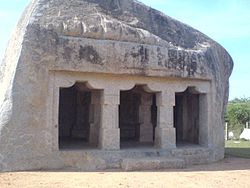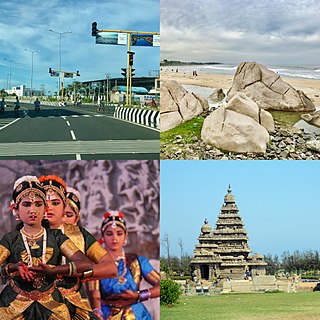
Mamallapuram, is a town in Chengalpattu district in the southeastern Indian state of Tamil Nadu, best known for the UNESCO World Heritage Site of 7th- and 8th-century Hindu Group of Monuments at Mahabalipuram. It is one of the famous tourist sites in India. The ancient name of the place is Thirukadalmallai. It is a part of Chennai Metropolitan Area. It is a satellite town of Chennai.

The Pallava dynasty existed from 275 CE to 897 CE, ruling a significant portion of the Deccan, also known as Tondaimandalam. The Pallavas played a crucial role in shaping in particular southern Indian history and heritage. The dynasty rose to prominence after the downfall of the Satavahana Empire, whom they had formerly served as feudatories.

Simhavishnu also known as Avanisimha son of Simhavarman III and one of the Pallava kings of India, was responsible for the revival of the Pallavan dynasty. He was the first Pallava monarch whose domain extended beyond Kanchipuram (Kanchi) in the South. He was portrayed as a great conqueror in Mattavilasa Prahasana, a drama written by his son Mahendravarman I.
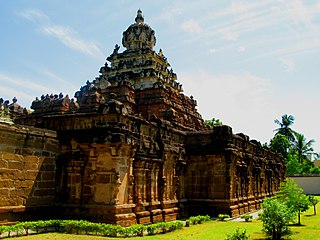
Kanchipuram also known as Kanjeevaram, is a stand alone city corporation, satellite nodal city of Chennai in the Indian state of Tamil Nadu in the Tondaimandalam region, 72 km (45 mi) from Chennai – the capital of Tamil Nadu. Known as the City of Thousand Temples, Kanchipuram is known for its temple architectures, 1000-pillared halls, huge temple towers and silk saris. Kanchipuram serves as one of the most important inland tourist destinations in India. Kanchipuram has become a centre of attraction for foreign tourists as well. The city covers an area of 36.14 km2 (13.95 sq mi) and an estimated population of more than 13,00,000 in 2021. It is the administrative headquarters of Kanchipuram District. Kanchipuram is well-connected by road and rail.

Sholinghappuram, currently shortened as sholinghur is a municipality under Sholinghur taluk in Ranipet District of Tamil Nadu, India. The town is famous in Tamil Nadu and other neighboring states for the Lakshmi Narasimha Swamy temple.
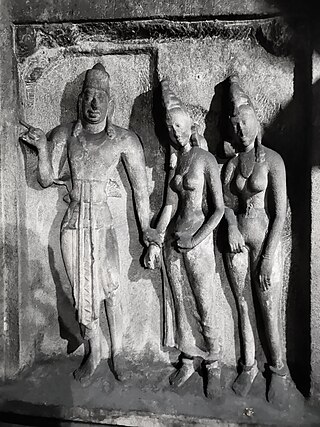
Mahendravarman I was a Pallava emperor who ruled over realm covering the southern portions of present-day Andhra region and northern regions of what forms present-day Tamil Nadu in India, in the early 7th century. He was a scholar, a painter, an architect and a musician. He was the son of Simhavishnu, who defeated the Kalabhras and re-established the Pallava kingdom.
Kaveripakkam is a town panchayat in Ranipet district in the Indian state of Tamil Nadu.

Tiruchirappalli Rock Fort, locally known as Malaikottai, is a historic fortification and temple complex built on an ancient rock. It is located in the city of Tiruchirappalli, on the banks of river Kaveri, Tamil Nadu, India. It is constructed on an 83 metres (272 ft) high rock. There are two Hindu temples inside, the Ucchi Pillayar Temple, Rockfort and the Thayumanaswami Temple, Rockfort. Other local tourist attractions include the famous Pallava-era Ganesha temple and the Madurai Nayak-era fort. The fort complex has witnessed fierce battles between the Madurai Nayakas and Adil Shahi dynasty of Bijapur, Carnatic region and Maratha Imperial forces. The fort played an important part during the Carnatic Wars, helping lay the foundations of the British Empire in India. The Rockfort is the most prominent landmark of the city.
Valathoor is a village about 8 kilometres (5 mi) from the town of Gudiyatham in Vellore District, Tamil Nadu, India. There is a railway station about 1 kilometre (1 mi) from the village near Ulli, with the village's name. This station is located in the Katpadi–Jolarpet mainline. There are trains to Bangalore and Chennai. The nearest town is Madanur, on the Chennai — Bengaluru Highway, which is about 2.5 kilometres (2 mi) from Valathoor.
Paranjothi, popularly known as Sirruthondar was an army general of the great Pallava king Narasimavarman I who ruled South India from 630–668 CE. He also led the Pallava army during the invasion of Vatapi in 642 CE. In the later years of his life, Paranjothi gave up violence and became a wandering Saivite monk, Sirruthonda nayanar. He is venerated as one of the 63 Nayanmars.
Seeyamangalam is a small village in Vandavasi taluk in Tiruvannamalai district in the Indian state of Tamil Nadu. The major occupation of the people living at this place is agriculture. As of 2011, it had a population of 1665. The place is known for the Avanibhajana Pallaveshwaram temple.
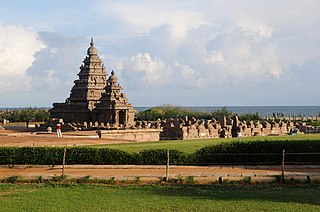
The Group of Monuments at Mahabalipuram is a collection of 7th- and 8th-century CE religious monuments in the coastal resort town of Mahabalipuram, Tamil Nadu, India and is a UNESCO World Heritage Site. It is on the Coromandel Coast of the Bay of Bengal, about 60 kilometres (37 mi) south of Chennai.

Varaha Cave Temple is a rock-cut cave temple located at Mamallapuram, on the Coromandel Coast of the Bay of Bengal in Kancheepuram District in Tamil Nadu, India. It is part of the hill top village, which is 4 kilometres (2.5 mi) to the north of the main Mahabalipurm sites of rathas and the Shore Temple. It is an example of Indian rock-cut architecture dating from the late 7th century. The temple is one of the finest testimonial to the ancient Hindu rock-cut cave architecture, out of many such caves also called mandapas. Part of the Group of Monuments at Mahabalipuram, the temple is a UNESCO World Heritage Site as inscribed in 1984 under criteria i, ii, iii and iv. The most prominent sculpture in the cave is that of the Hindu god Vishnu in the incarnated form of a Varaha or boar lifting Bhudevi, the mother earth goddess from the sea. Also carved are many mythical figures.

The Shore Temple is a complex of temples and shrines that overlooks the shore of the Bay of Bengal. It is located in Mahabalipuram, about 60 kilometres (37 mi) south of Chennai in Tamil Nadu, India.

Mahishasuramardhini Mandapa is an example of Indian rock-cut architecture dating from the late 7th century, of the Pallava dynasty. It is a rock-cut cave temple located on a hill, near a lighthouse, along with other caves in Mamallapuram. Mamallapuram, also popularly known as Mahabalipuram, is a small village to the south of Chennai, in the state of Tamil Nadu, India. The temple is part of the Group of Monuments at Mahabalipuram, a UNESCO World Heritage Site inscribed in 1984. This Cave Temple has many interesting architectural features of which three exquisitely carved reliefs on the cave walls of three sanctums are prominent. One is of Vishnu reclining on the seven hooded serpent, Adishesha, another of Durga, the main deity of the cave temple Durga slaying the buffalo headed demon Mahishasura, and the third sanctum has a sculpture of Shiva.

Ganesha Ratha is a temple in Kancheepuram district, Tamil Nadu, India. It is one of ten rathas ("chariots") carved out of pink granite within the group of monuments of the Pallava Period at Mahabalipuram, a UNESCO-inscribed World Heritage Site since 1984. The ratha is an example of monolith Indian rock-cut architecture dating from the late seventh century during the reign of King Mahendravarman I and his son Narasimhavarman I. Initially constructed with a Shiva Linga, it is now deified with a Ganesha deity after the linga was removed.

Mamandur is a village in Tiruvanamalai district of Tamil Nadu, India. It is located on the Kanchipuram - Vandavasi road, near Dusi and about 10 km from Kanchipuram. It is known for the 7th-century rock-cut cave temple, housing a Tamil Brahmi inscription, one of the monuments of national importance as declared by the Archaeological Survey of India.

Mahabalipuram Lighthouse is located in Tamil Nadu, India. It has been open to tourists since 2011. It was closed in 2001 following a perceived threat from the Liberation Tigers of Tamil Eelam. The first light was commissioned here in 1887 on the roof of the Olakkannesvara Temple. The lighthouse, with a circular masonry tower made of natural stone, became fully functional in 1904. India's oldest lighthouse, built around 640 CE by Pallava king Mahendravarman I stands next to this modern structure. The Pallava era lighthouse is a protected monument, maintained by the Archaeological Survey of India.

Avanibhajana Pallaveshwaram temple also called Stambeswarar Temple is a Hindu temple dedicated to Shiva, located in the town of Seeyamangalam, Tiruvannamalai district in Tamil Nadu, India. The temple is constructed in Rock-cut architecture by the Pallava king Mahendravarman I during the 7th century. The cave temple had later additions from the Chola and Vijayanagar Empire.
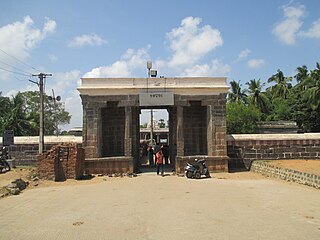
Nithyakalayana Perumal temple in Thiruvidandai, a village in Chennai, Chengalpattu district of the South Indian state of Tamil Nadu, is dedicated to Varaha, the boar avatar of the Hindu god Vishnu. Constructed in the Tamil style of architecture, the temple is glorified in the Naalayira Divya Prabandham, the early medieval Tamil canon of the Alvar saints from the 6th–9th centuries CE. It is one of the 108 Divya Desams dedicated to Vishnu, who is worshipped as Nithyakalayana Perumal (Varaha) and his consort Lakshmi as Komalavalli Thayar. The original structure of the temple was built by the Pallavas during the 7th century CE, with later additions from the Cholas during the 11th century.
